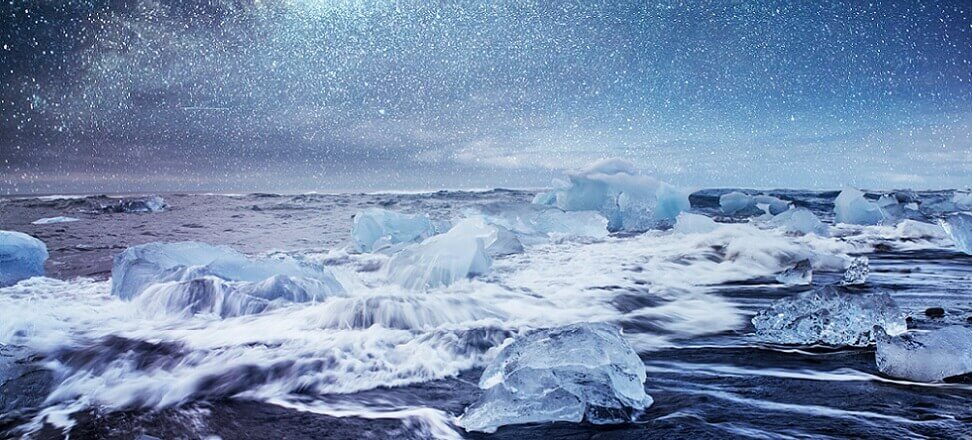Mother Nature is certainly smarter than my Earth-bound mind – Kevin Peter Hand, 2022, Extraterrestrial Oceans. We know what life is like on Earth, although we can’t draw a precise line between what is and isn’t life. We are also not entirely sure of its origins.
As Earthlings, we are believers in carbon, but the life of other worlds may be built from quite different bricks and rely on other mechanisms of energy processing and information storage. It works on the imagination of Hand’s proposed Periodic Table of Life – a hypercube in which elements that can build life are connected in many ways. Will we someday save its multidimensional tables with data describing the species encountered in the Universe? In the ocean on Europa, the role of some of the carbon atoms in the equivalent proteins there could be taken up by atoms of sulfur commonly found on its surface from the moon Io.
Hand weaves visions of the life that might have developed in the oceans of Europa and other ice worlds. However, he strongly emphasizes that these are only speculations based on currently available data. He also recalls the words of Carl Sagan, the father of astrobiology, who recommended rejecting all other possibilities first before discussing life at all. In projecting life in Europa’s ocean, Hand supports the Gaia Hypothesis [1], and for an astrobiologist, he does so carefully indeed, building models of alien, oceanic fauna based on the set of senses available to earthly organisms. I don’t always second him.
Astrobiological earth-centrism – who needs eyesight?
One of the main problems Hand believes life would have in the thick ice-covered oceans would be access to light. The author paves the way for chemoluminescence. He also wonders how much light could penetrate with a thinner ice sheet to justify the evolutionary investment in the sense of sight. It’s an approach from the perspective of life as we know it, but we’re probably doomed to mentally search for biologies modeled on our own, Earth’s. The aphotic zone in the Earth’s oceans, with much more available light from the sun, begins at a depth of a kilometer. Sperm whales hunting in this zone locate prey by sound. To float a consideration for an ice crust that is at least several kilometers thick could, therefore, be considered an exaggeration.
The troglobionts I deal with every day in the flooded caves of Mexico have found the sense of sight to be an unnecessary luxury, and there are predators among them [2]. However, observing the troglophilic mirth born on the surface [3], flowing behind divers into the deeper parts of the caves and taking advantage of their light to carry out a veritable slaughter of the sightless organisms living there, I agree that sight would give an incredible advantage to predators that would suddenly see through their eyes in this blind world. Sight on Earth, after all, has appeared many times. Only that it would rather lead to the extinction of predators, which would die of starvation after a phase of dynamic growth caused by an excess of food, after mass extermination of their blind victims… As a realist, I am a supporter of the Medea Hypothesis [4].
Other senses, other possibilities…
Hand fortunately draws attention to other senses that organisms in Earth’s oceans have developed that are more practical under these conditions: the lateral line, which responds to changes in pressure, and the electrical sense (the heart of an oviparous shark embryo can stop beating when an adult swims by). It also designs life, which, instead of incorporating living organisms – e.g., mitochondria as energy-producing organelles, expanded the nervous system based on permanent memory and processors to improve the conversion of complex data. Such capabilities could be used by ocean dwellers, for example, to calculate the variability of Jupiter’s magnetic field, in which Europa is bored. In doing so, he takes inspiration from Earth’s bacteria, which produce nanocrystals of magnetite along the axis of the cell, enabling them to align themselves along the lines of the Earth’s magnetic field.
Hand mentions a truly different life than that based on carbon by the way of methane spills on Titan and Kuiper Belt objects. He recalls that alien life forms can be made of gases, solids or plasma. So that when we look at them, we may not recognize living beings in them….
Technomimicry of oceanic civilization
Hand points out that while it is not easy to imagine the development of metallurgy in the depths of the oceans, biology can always be put to work. Take the example of corals, which are probably close to everyone who loves diving. They have built the largest structure on Earth in terms of area and visible from space [5]. Corals use other organisms – zooxanthellae – on a massive scale to obtain energy, controlling their biology. This every diver knows. Hand recalls diatoms, which use silicon available in water to build their cell walls.
By manipulating the biology of other organisms, advanced structures can be built over hydrothermal vents. The structures, which the astrobiologist says could direct the flow of electrons and chemicals from the stacks. Luminescence could appear in them, illuminating the alien underground ocean. The brain until it heats up, populating the depths of other worlds with exotic civilizations… [6].
Cosmology, religion, aliens – visions of the Universe….
At the end, Hand asks a question about the mental condition and philosophical features of a civilization that would have grown up without stars. On what basis would she build her transcendence? Would she ever even realize the existence of Jupiter, which her world orbits in 3.55 of its local day. Jupiter’s powerful and variable magnetic field is, after all, next to gravity, the main driving force on Europa and the largest single structure in the Solar System. Would the civilization there deduce the existence of the Sun, stars and the Universe? Our gods have always lived among the stars… How could we understand each other with such a very different reality?
To boldly go where no man has gone before….
Perhaps the depths of the oceans, which do not meet our requirements for inhabitability, are teeming with happy life. This is just another reason to go there and check it out – Kevin Peter Hand, 2022, Extraterrestrial Oceans.
The book was published in Poland in 2022, two years after the original edition. This time has not changed much in the astronomical scale of our exploration of the solar system. On September 21, 2003. Galileo probe dived into Jupiter, perishing in its immense pressure. Cassini probe September 15, 2017. made a final dive, suicidally diving toward Saturn. All this to protect possible life in the oceans of Europa and Enceladus. New Horizons in 2015. sent photos of Cerberus and Styx, the next moons of Pluto discovered at the beginning of the same decade.
Starting in 2019. Transmits data on passing Kuiper Belt objects. It’s a shame that NASA just withdrew its funding. Voyagers flash onward toward deep space. In 300 years, Voyager 1 will reach the Oort cloud, which it will traverse for another 30,000. years. Too bad it will only have enough battery for the next two. In 40,272 it may have passed the star Gliese 445. Unfortunately, in early December, just before the first part of the article was published, NASA reported that the probe’s systems had malfunctioned and began transmitting unintelligible digital gibberish to Earth instead of telemetry.
A similar situation has already occurred in 2022. , so let’s hope that NASA engineers will be able to solve the space problem again [7]. At 40,176 Voyager 2, which is also scheduled to run out of energy in two years, may pass the Ross 248 star. In 294,000 years it may fly near Sirius. As long as none of them hit anything along the way… Will anyone then wonder if life could ever exist on Earth?
What’s next for dreams of the oceans of Europa and other solar system worlds?
Hand describes the funding problems facing NASA’s upcoming science missions. In October 2024. The agency plans to launch its own Europa Clipper probe – 15 years later than originally declared. Kevin Peter Hand, who has been waiting for this lander since he was a child, is instead taking part in the Titan Dragonfly mission. The probe is expected to search for signs of life on Titan, also a moon of Saturn endowed with an underground ocean. The missions that will be able to entrain themselves to dive into the depths of Europa, Enceladus, Titan, Ganymede or Kallisto, however, will set off no sooner than in another 30 years. As Hand says – this is not a job for the faint of heart….
Already after the release of Hand’s book, on September 21, 2023, NASA reported the discovery of carbon dioxide in the Tara Regio region on Europa’s surface, which must come from the moon’s subsurface ocean. Earlier, still using the Hubble telescope, salt from the same ocean was detected here [8]. The depths of Europe are calling…
From French Guiana on April 14, 2023. An Ariane 5 rocket with the European Space Agency’s Juice mission [9] took off. The Juice probe is expected to reach Jupiter after eight years, in July 2031. [10] Along the way, it will pass the Asteroid Belt, perhaps also contributing to the recognition of elements of this no less important horizon for the future of the Earth [11]. Eleven measurement systems were on board the probe [12], well thought out after the Galileo and Cassini missions.
The goal of the Jupiter Icy Moons Explorer (Juice) is to observe the subsurface ocean-containing moons: Europa, Ganymede and Callisto. On May 12, 2023, Juice finally unfolded the RIME antenna, manufactured by the German company SpaceTech, which did not open properly on schedule, after the launch [13]. All the more let’s keep our fingers crossed for the deployable RWI antenna and LP-PWI detectors [14] Polish company Astronika [15], which are part of the RPWI experiment aboard Juice. And for more Polish accents in the space….
In the article, I used, among other things. From the works:
[1] The Gaia hypothesis states that all living organisms work together to keep the planet in biological balance. He formulated it in the 1970s. James Lovelock during NASA’s preparations for the Viking mission, one of whose tasks was to search for signs of life on Mars.
[2] The flooded caves of the Yucatan are home to organisms that have given up their sense of sight as part of their adaptation, including predators such as the ghost fish (Typhliasina pearsei), the blind cave eel (Ophisternon infernale) and the venomous shovelnose (Xibalbanus tulumensis). They also hunt sightless invertebrates.
[3] The Mexican mirrorfish (Astyanax mexicanus) is an interesting example of a species that lives in two forms and two environments. Individuals that reside permanently in caves lose their eyes, but significant numbers enter caves behind cave divers, using their lights to hunt defenseless troglobionts.
[4] The Medea hypothesis was formulated in 2009. by Peter Ward, as the opposite of the Gaia Hypothesis. He believes that every species is moving toward self-destruction by maximizing the use and ultimately exhausting the available resources. A good example of this would be the Overkill Theory, which explains the extinction of megafauna on all continents except Africa, some time after humans arrived there (the animals of Africa, the cradle of our species, had time to learn to escape from us).
[5] Visible from space, Australia’s Great Barrier Reef (2,300 km) is admittedly a bit shorter than the erstwhile Great Wall of China (~2,400 km), but it has a much larger surface area than it (344.4 thousand. km2).
[6] Biology also provides tools – Helen Scales in her book The Abyss: The Hidden Life of the Oceans… cites the example of an octopus that preserved the tentacles of a hunted discus armed with knids (parsimony).
[7] https://blogs.nasa.gov/sunspot/2023/12/12/engineers-working-to-resolve-issue-with-voyager-1-computer/
[8] On September 21, 2023, the day NASA announced revelations about carbon dioxide in the recently resurfaced Tara Regio region of Europa, two papers were published on the subject: Samantha K. Trumbo, Michael E. Brown (2023) The distribution ofCO2 on Europa indicates an internal source of carbon. “Science” 381:1308-1311. https://doi.org/10.1126/science.adg4155 and G. L. Villanueva et al. (2023) EndogenousCO2 ice mixture on the surface of Europa and no detection of plume activity. „Science” 381:1305-1308 https://doi.org/10.1126/science.adg4270.
[9] About ESA’s Jupiter Icy Moons Explorer mission https://www.esa.int/Science_Exploration/Space_Science/Juice
[10] The probe won’t skip toward Jupiter until January 2029, picking up speed after four consecutive gravitational assists around Venus and Earth.
[11] On the future war for Belt resources and the extraction of raw materials from asteroids: Martin Elvis Asteroids: How love, fear and greed will determine our future in space, Copernicus Center Press 2022.
[12] These include the JANUS camera, MAJIS hyperspectral spectrometer, UVS spectrometer, SWI heterodyne spectrometer, GALA lidar, RIME radar, J-MAG magnetometer, PEP plasma analyzer, RPWI radio and plasma receiver, 3GM transponder and PRIDE interferometer.
[13] About the more than a month-long problems with the deployment of the radar antenna of the JUICE probe: https: //www.esa.int/Science_Exploration/Space_Science/Juice/Solving_the_RIME_deployment_mystery
[14] LP-PWI (Langmuir Probe – Plasma Wave Instrument) are fold-out booms terminated with plasma electric potential probes. The main purpose of the booms is to deploy probes within 3 meters of the spacecraft to enable them to study the plasma environment in Jupiter’s magnetosphere.
[15] https://astronika.pl/we-got-it-mechanisms-developed-by-a-polish-company-worked-on-their-way-to-jupiter/

 Polski
Polski






